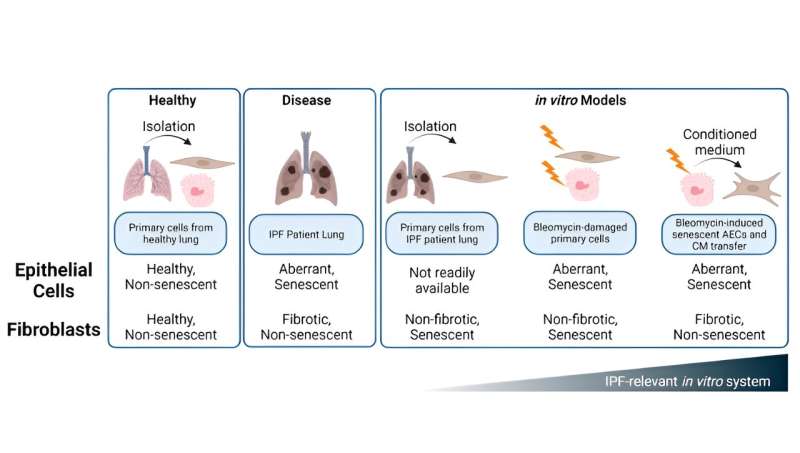This article has been reviewed according to Science X's editorial process and policies. Editors have highlighted the following attributes while ensuring the content's credibility:
fact-checked
proofread
Modulating in vitro lung fibroblast activation via senolysis of senescent human alveolar epithelial cells

A new research paper titled "Modulating in vitro lung fibroblast activation via senolysis of senescent human alveolar epithelial cells" has been published in Aging.
Idiopathic pulmonary fibrosis (IPF) is an age-related disease with poor prognosis and limited therapeutic options. Activation of lung fibroblasts and differentiation to myofibroblasts are the principal effectors of disease pathology, but damage and senescence of alveolar epithelial cells, specifically type II (ATII) cells, has recently been identified as a potential trigger event for the progressive disease cycle. Targeting ATII senescence and the senescence-associated secretory phenotype (SASP) is an attractive therapeutic strategy; however, translatable primary human cell models that enable mechanistic studies and drug development are lacking.
In this new study, researchers Joseph S. Spina, Tracy L. Carr, Lucy A. Phillips, Heather L. Knight, Nancy E. Crosbie, Sarah M. Lloyd, Manisha A. Jhala, Tony J. Lam, Jozsef Karman, Meghan E. Clements, Tovah A. Day, Justin D. Crane, and William J. Housley from AbbVie Bioresearch Center and Northeastern University describe a novel system of conditioned medium (CM) transfer from bleomycin-induced senescent primary alveolar epithelial cells (AEC) onto normal human lung fibroblasts (NHLF) that demonstrates an enhanced fibrotic transcriptional and secretory phenotype compared to non-senescent AEC CM treatment or direct bleomycin damage of the NHLFs.
"In the current study, we confirm the presence of senescent cell populations within the human IPF lung, as well as assess primary cell reagents for sensitivity to senescent cell targeting therapies," the team states.
In this system, the bleomycin-treated AECs exhibited classical hallmarks of cellular senescence, including SASP and a gene expression profile that resembles aberrant epithelial cells of the IPF lung. Fibroblast activation by CM transfer was attenuated by pre-treatment of senescent AECs with the senolytic Navitoclax and AD80, but not with the standard of care agent Nintedanib or senomorphic JAK-targeting drugs (e.g., ABT-317, ruxolitinib). This model provided a relevant human system for profiling novel senescence-targeting therapeutics for IPF drug development.
"Taken together, the model described herein provides a physiologically relevant, primary human cell system to study the effects of alveolar epithelial cell senescence on lung fibroblasts in the context of chronic fibrotic lung disease," the team notes.
More information: Joseph S. Spina et al, Modulating in vitro lung fibroblast activation via senolysis of senescent human alveolar epithelial cells, Aging (2024). DOI: 10.18632/aging.205994



















